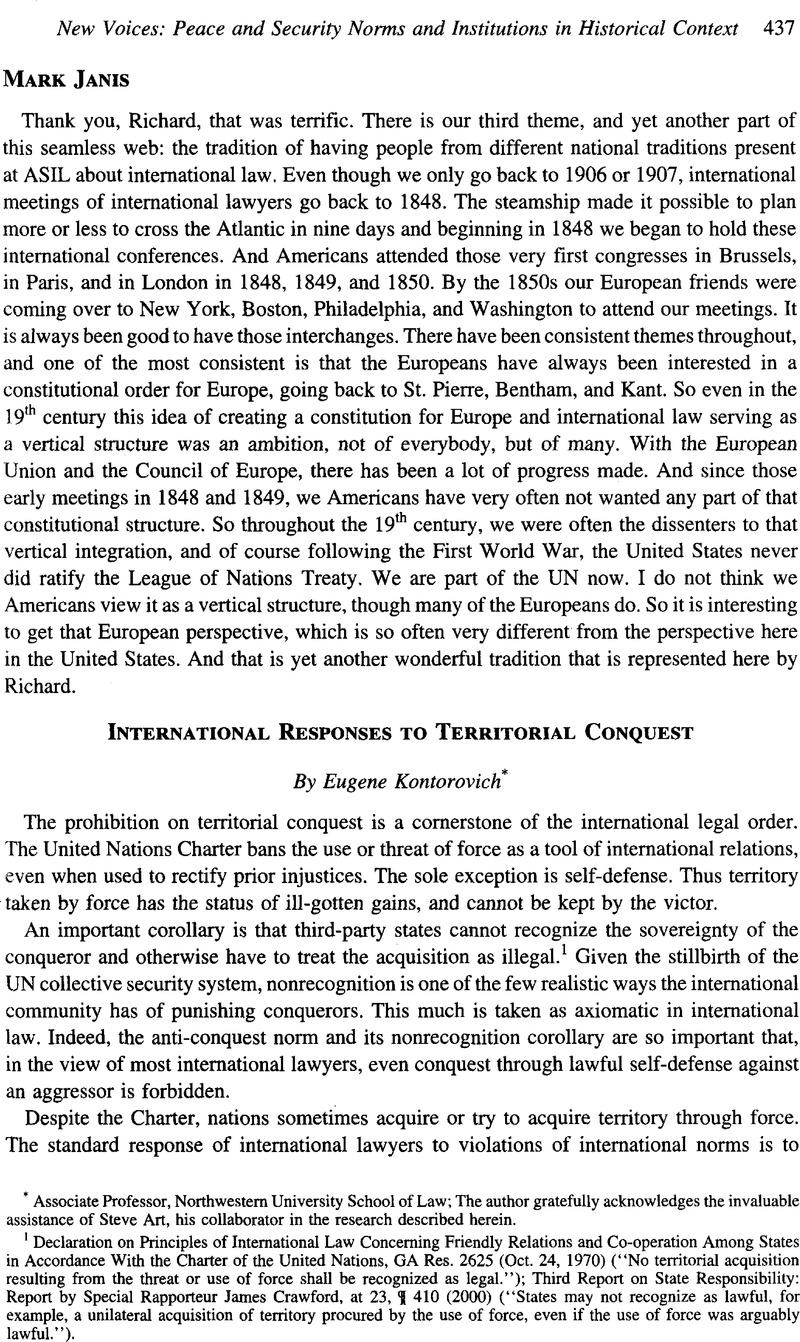No CrossRef data available.
Article contents
International Responses to Territorial Conquest
Published online by Cambridge University Press: 28 February 2017
Abstract

- Type
- New Voices: Peace and Security Norms and Institutions in Historical Context
- Information
- Copyright
- Copyright © American Society of International Law 2008
References
1 Declaration on Principles of International Law Concerning Friendly Relations and Co-operation Among States in Accordance With the Charter of the United Nations, GA Res. 2625 (Oct. 24, 1970) (“No territorial acquisition resulting from the threat or use of force shall be recognized as legal.”); Third Report on State Responsibility: Report by Special Rapporteur James Crawford, at 23, ¶ 410 (2000) (“States may not recognize as lawful, for example, a unilateral acquisition of territory procured by the use of force, even if the use of force was arguably lawful.”).
2 Zacher, Mark, The Territorial Integrity Norm: International Boundaries and the Use of Force, 55 Int’L Org. 215 (2001)CrossRefGoogle Scholar; Tir, Jaroslav, et al., Territorial Changes, 1816-1996: Procedures and Data, 16 Conflict Mgmt. & Peace Sci. 89 (1998)CrossRefGoogle Scholar.
3 See Korman, Sharon, The Right of Conquest: The Acquisition of Territory by Force in International Law and Practice 249-302 (1996)Google Scholar.
4 Perhaps international condemnation could affect the success of an attempted conquest—though short of intervention, as in Korea and Iraq, the mechanism of such an effect is obscure. In such a case, a study of consummated conquests would be biased towards those territory-seeking aggressions of which the international community is more tolerant.
5 One can debate, for example, whether to include situations where the force was largely applied before the adoption of the charter, but the conquest was in some sense consummated afterwards—such as the redistribution of territory from Axis powers to other states in 1947, or South Africa’s presence in Southwest Africa (Namibia).
6 The clearest are Morocco’s taking of Spanish territory in Western Sahara and Indonesia’s taking of Portuguese East Timor, both in 1975. Both were condemned by Security Council resolutions. Israel’s taking of Syrian, Egyptian, and Jordanian-occupied territory in 1967 received a mix of condemnation and approval in Security Council resolution 242, but was clearly denounced in a subsequent General Assembly resolution.
7 China/Tibet in 1950 and North Vietnam/South Vietnam in 1975. Other conquests that are almost universally treated as part of the sovereign territory of the conqueror are India’s takeover of Portuguese territories in 1961 and Indonesia’s conquest of Dutch New Guinea in 1963. Both Indian and Pakistani acquisitions in the Kashmir are widely treated as de facto parts of those countries, but this might also be a case of acquiescence.
8 These conquests include smaller territorial changes, such as Egypt/Palestine (1949), Jordan/Palestine (1949), China/India (1962), Iran/United Arab Emirates (1971), China/South Vietnam (1974), Libya/Chad (1973-87).
9 Notable examples included Vietnam/Laos, Vietnam/Cambodia Syria/Lebanon, U.S.S.R./Afghanistan, and much more controversially, Nato/Serbia (in Kosovo).


